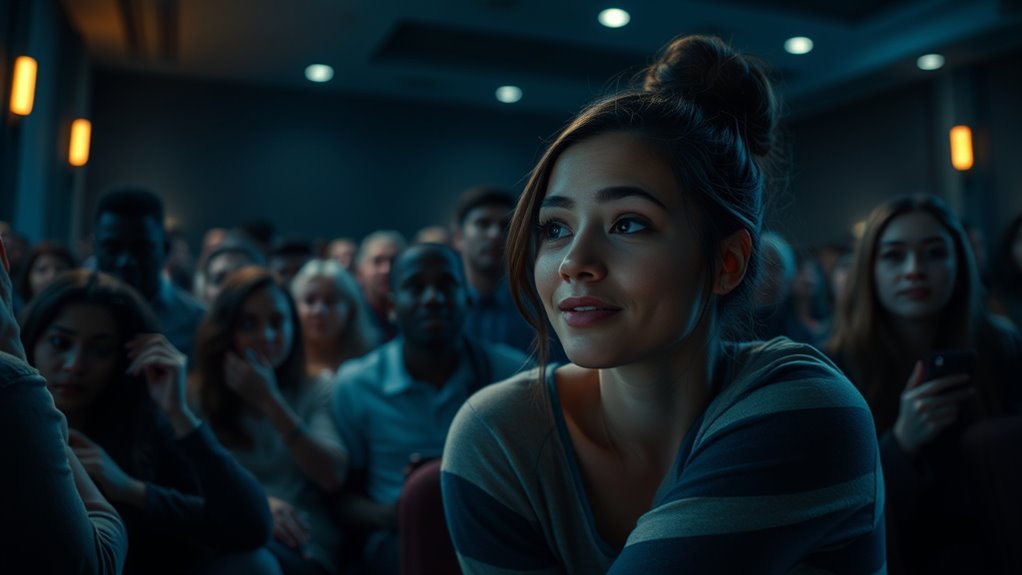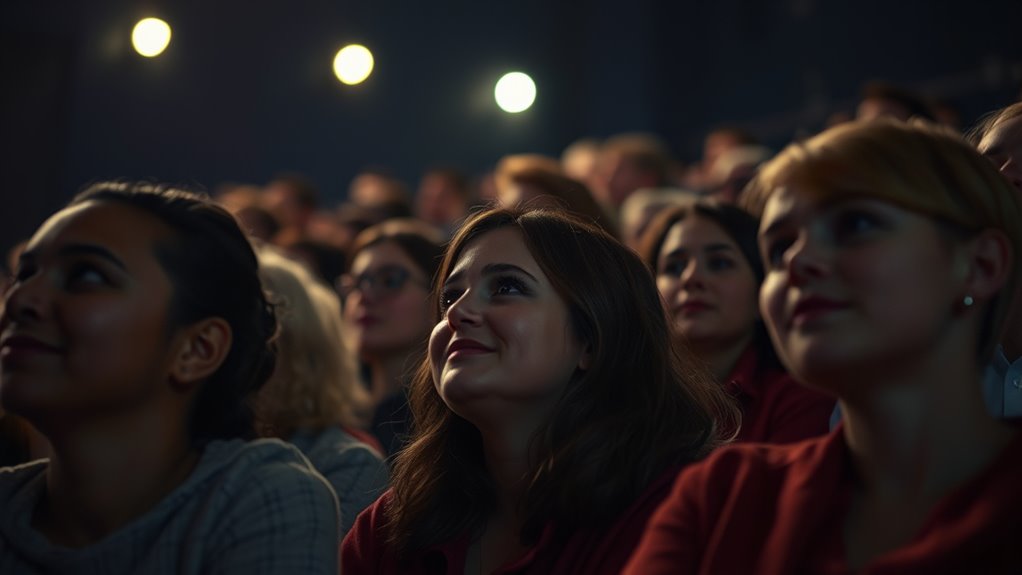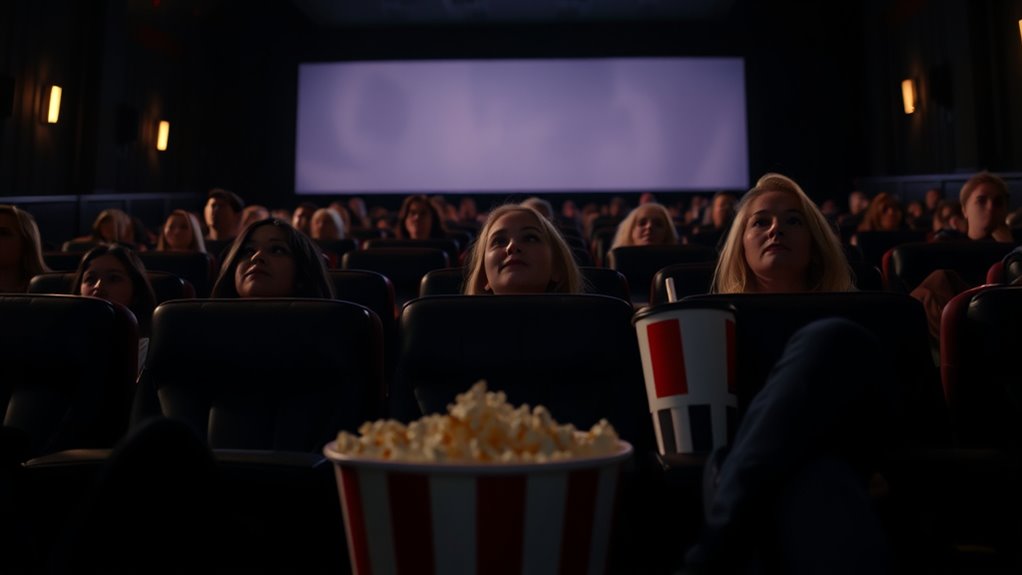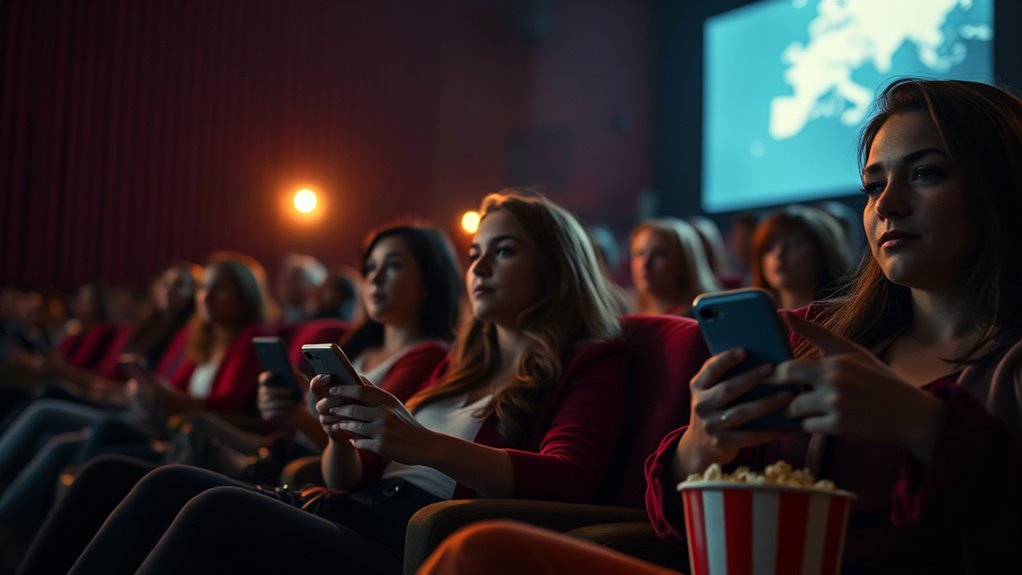Post-credit scenes tap into your curiosity and desire for surprises, triggering anticipation and releasing dopamine with visual and auditory cues. They strengthen emotional bonds with characters and storylines, motivating you to stay until the end. Social habits and franchise loyalty also play a role, encouraging you to follow the narrative beyond the main event. If you keep exploring, you’ll uncover more about how cinematic tricks and cultural cues make this habit so compelling.
Key Takeaways
- Post-credit scenes activate curiosity and anticipation, triggering dopamine releases that enhance excitement and motivate viewers to stay until the end.
- Visual and auditory cues create subconscious rewards, reinforcing the habit of waiting through suspense and mystery.
- Narrative continuity and character development deepen emotional investment, encouraging viewers to follow story extensions.
- Cultural rituals and social influences, like group movie nights, promote collective behavior of remaining seated during credits.
- Cinematic techniques such as symbolism and mood-setting heighten curiosity, reinforcing psychological engagement and ongoing discovery.
The Power of Curiosity and Anticipation

The power of curiosity and anticipation lies in their ability to keep viewers engaged long after the main story ends. You’re drawn in by visual anticipation, enthusiastic to see what’s next, even if the scene appears finished. This suspense buildup creates a craving for resolution, making you stay seated. It taps into your natural desire to know more, sparking a mental puzzle that needs solving. As you watch, your brain releases dopamine, heightening excitement and focus. The skillful use of visual cues and subtle hints fuels this curiosity, encouraging you to linger. This psychological tug keeps you invested, turning a simple screen pause into a compelling experience. Additionally, contrast ratio plays a role in how vividly scenes are perceived, making the anticipation even more immersive. Ultimately, it’s this blend of suspense buildup and visual anticipation that transforms a post-credit scene into a powerful tool for audience engagement.
The Impact of Narrative Continuity on Audience Engagement

When a story maintains strong narrative continuity, your anticipation grows, making you more curious about what’s next. This connection also deepens your emotional investment, as you become more connected to the characters and plot. Ultimately, patience is rewarded when the story’s threads come together, keeping you engaged and enthusiastic for the final reveal. Recognizing relationship dynamics within the storyline can further enhance your understanding and appreciation of the narrative’s depth.
Anticipation Builds Curiosity
Because narrative continuity seamlessly connects post-credit scenes to the main story, it fuels anticipation that keeps you enthusiastic for what’s next. Visual cues, like a recurring symbol or familiar setting, hint at future plotlines, while ambient sound builds suspense—rumbling tones or subtle whispers heightening curiosity. This connection creates a sense of coherence, making the scene feel essential rather than filler. You stay seated because your mind races to piece together clues, wondering how it all fits. The following table illustrates how visual cues and ambient sound work together to amplify curiosity:
| Visual Cues | Ambient Sound | Effect |
|---|---|---|
| Recurrent symbols | Suspenseful music | Builds anticipation for upcoming scenes |
| Familiar settings | Whispering or low hum | Heightens intrigue |
| Character appearances | Echoes or subtle noise | Sparks curiosity about future roles |
| Visual motifs | Silence or faint sounds | Keeps you hooked and eager to see more |
| The use of consistent branding can also reinforce narrative continuity, making the scene more memorable.
Emotional Investment Deepens
Post-credit scenes that connect seamlessly to the main story do more than just tease future plotlines—they forge a stronger emotional bond between you and the characters. When these scenes deepen the narrative, your emotional attachment grows as you see how characters’ struggles and triumphs continue beyond the main events. This continuity encourages you to invest more in their journeys, making you care about their fates. It also tests your viewer patience, rewarding your willingness to stay seated and engaged. Over time, this sustained emotional investment transforms your viewing experience from passive entertainment to a meaningful connection. By linking scenes and storylines, filmmakers tap into your emotions, fostering loyalty and anticipation that keeps you coming back. Additionally, incorporating story continuity elements helps maintain your engagement and reinforces the narrative’s emotional impact.
Narrative Rewards Patience
Narrative continuity in post-credit scenes encourages patience by rewarding viewers who stay engaged. When a scene connects to the film’s overall story, it enhances character development and deepens your understanding of the plot. This continuity creates anticipation, prompting you to stay seated for that payoff. Visual symbolism often underscores this connection, hinting at future storylines or character arcs. Here’s a quick look at how this works:
| Element | Effect on Engagement | Example |
|---|---|---|
| Character development | Builds emotional investment | Revealing a hero’s true motives |
| Visual symbolism | Creates intrigue and anticipation | Symbolic objects hinting at future events |
| Narrative rewards | Reinforces patience with payoff | Post-credit scenes that tie back to main story |
| Continuity | Maintains story flow and coherence | Linking scenes across the film |
Psychological Rewards and the Desire for Surprises

When you watch for post-credit scenes, your anticipation builds excitement and keeps you engaged. Uncertainty about what’s coming next sparks your curiosity, making the wait more thrilling. Hidden rewards tap into your desire for surprises, encouraging you to stay invested until the very end. Additionally, the safety features of modern devices ensure that the experience remains secure and worry-free.
Anticipation Builds Excitement
Anticipation naturally heightens your excitement as you wait for that elusive post-credit scene to appear. Your brain responds to visual cues, like flickering lights or subtle movements, signaling that something’s about to happen. Auditory cues, such as faint sounds or music, also amplify this feeling, keeping you engaged and alert. These cues trigger your brain’s reward system, releasing dopamine and intensifying your enthusiasm. As you focus on these signals, your desire for a surprise grows stronger, making the wait feel even more rewarding. The combination of visual and auditory cues keeps you rooted in your seat, heightening your anticipation and ensuring you stay through the credits. It’s this build-up that transforms a simple scene into an exciting, memorable moment. Incorporating familiar ice cream flavors or treats during the wait can also enhance the experience, making the anticipation even sweeter.
Uncertainty Fuels Curiosity
Have you ever noticed how the mystery of an unanswered question or an unfinished story sparks your curiosity? That’s because your brain relies on predictive processing, constantly making guesses about what might happen next. When a post-credit scene leaves things unresolved, your mind seeks to fill in the gaps, driven by a natural desire for novelty seeking. This uncertainty creates a psychological reward, as your brain becomes engaged in solving the puzzle. The unpredictability keeps you hooked, encouraging you to stay seated and watch until the very end. It’s not just about the story; it’s about the thrill of discovery and the satisfaction of uncovering something new. That’s the power of uncertainty—fueling your curiosity and rewarding your brain’s craving for surprises. Additionally, the anticipation of potential story resolution motivates viewers to remain engaged and attentive.
Hidden Rewards Drive Engagement
Uncertainty in post-credit scenes doesn’t just spark curiosity—it also triggers hidden psychological rewards that keep viewers engaged. These moments activate subconscious triggers, tapping into your desire for surprises and the thrill of discovery. When you stay seated, you’re chasing hidden incentives—a sense of accomplishment, anticipation, or connection to the story’s universe. These rewards are often subconscious but powerful, encouraging repeated engagement. Here’s a look at how this works:
| Hidden Incentives | Subconscious Triggers | Psychological Rewards |
|---|---|---|
| Anticipation of surprises | Sense of belonging | Satisfaction from discovery |
| Curiosity about future plot | Desire for novelty | Excitement and intrigue |
| Connection to characters | Emotional resonance | Feeling of being in-the-know |
| Earning insider knowledge | Reward anticipation | Increased loyalty |
Social and Cultural Influences on Movie-Watching Habits

Social and cultural factors profoundly shape how and when you watch movies, influencing your preferences, habits, and expectations. Cultural rituals, like gathering with family for weekend movies or attending special screenings, create shared experiences that reinforce your habits. Social conformity also plays a role, as you often watch films popular within your community or peer group to fit in or gain social approval. These influences guide your choices, from genre preferences to the decision to stay seated for post-credit scenes. Cultural norms and expectations establish routines that become automatic, making movie-watching a collective activity rooted in tradition. Recognizing these factors helps you understand why certain habits persist and how social pressures subtly steer your engagement with films. Additionally, environmental cues such as theater layout and seating arrangements can influence whether viewers choose to remain seated during post-credit scenes.
The Role of Branding and Franchise Loyalty

Branding and franchise loyalty considerably influence your movie-watching choices, often guiding you toward familiar characters, stories, and aesthetics. Your connection to a franchise’s identity makes you more likely to stay seated during post-credit scenes, enthusiastic for future developments. When you trust a brand or feel a sense of loyalty, you’re motivated to see how the story unfolds and to support the franchise’s continued success. This brand loyalty creates a sense of belonging and anticipation, reinforcing your commitment to the franchise. As a result, you’re more inclined to stay through the credits, knowing that additional scenes might reveal new characters, plot twists, or hints about upcoming installments. Ultimately, your attachment to a franchise’s identity keeps you engaged long after the main story ends, especially when diverse designs are involved that enhance the overall experience.
How Cinematic Techniques Enhance Post-Credit Appeal

Cinematic techniques play a crucial role in making post-credit scenes more engaging and memorable. They leverage visual storytelling and cinematic symbolism to create anticipation and deepen the narrative. For example, carefully chosen lighting sets a mood that hints at future plot twists, while strategic camera angles focus your attention on subtle clues. Sound design, like a crescendo or whisper, heightens your emotional response, making the scene linger in your mind. Additionally, symbolism—such as recurring motifs or color schemes—connects post-credit scenes to overarching themes, enriching your experience. Using environmental considerations, filmmakers can also incorporate natural elements or settings that resonate with the story’s tone and message. These techniques work together to draw you in, enthusiastic to uncover what’s next. They transform a simple scene into a powerful storytelling device that keeps you hooked long after the credits roll.
Frequently Asked Questions
How Do Individual Personality Traits Influence Staying for Post-Credit Scenes?
Your personality traits heavily influence whether you stay for post-credit scenes. If you’re naturally curious and enjoy exploring mysteries, your viewer curiosity drives you to wait and see what’s next. On the other hand, if you’re more impatient or less engaged, you might leave early. Those with open-mindedness and a love for surprises tend to stay, while others prioritize getting to the exit. Your traits shape how you experience these moments.
What Neurological Processes Are Involved in the Anticipation of a Post-Credit Scene?
When you anticipate a post-credit scene, your brain activates expectancy pathways, signaling that something exciting is coming. This triggers dopamine release, which heightens your alertness and pleasure response. As your brain predicts the reward, these neurological processes reinforce your desire to stay seated, making the experience more engaging. Fundamentally, your brain’s anticipation and dopamine-driven reward system work together to keep you enthusiastic and attentive during those final moments.
How Do Marketing Strategies Impact Audience Expectations of Post-Credit Scenes?
Ever notice how marketing strategies turn you into a loyal minion? Franchise branding and merchandise tie-ins hype up post-credit scenes, making you enthusiastic for more. Studios craft clues and teasers to set expectations, ensuring you stay seated, eyes glued. They know your anticipation feeds their empire, turning every scene into a marketing goldmine. So, next time you anticipate that scene, thank clever branding for keeping you hooked—without even realizing it.
Can Cultural Differences Affect the Likelihood of Viewers Watching Post-Credit Scenes?
Cultural differences substantially influence whether viewers watch post-credit scenes because cultural storytelling shapes viewer engagement. In some cultures, audiences value tradition and may see post-credit scenes as unnecessary, while others enjoy the added layer of storytelling. Your viewing habits are affected by these cultural norms, making you more or less likely to stay seated. Ultimately, cultural storytelling impacts how engaged you are with extra content, affecting your overall movie experience.
What Role Does Social Media Play in Shaping Post-Credit Scene Viewing Habits?
It’s no coincidence that social media heavily influences your post-credit scene habits. You probably see fan theories and spoiler culture shaping your expectations, making you more inclined to stay seated. Platforms like Twitter and TikTok keep you engaged, fueling curiosity and anticipation. Social media creates a buzz that encourages you to watch every scene, fearing you’ll miss vital plot points or fun theories shared by fellow fans.
Conclusion
So, next time you’re glued to your seat after the credits roll, remember it’s your mind’s curiosity sparking a treasure hunt, craving surprises and story continuations. That lingering anticipation is like a magnetic pull, guiding you through a cinematic maze woven with tricks and treats. Your social ties and franchise loyalty are the threads pulling you deeper, turning a simple movie into an unforgettable adventure. Stay seated—your curiosity’s compass is just getting started.









